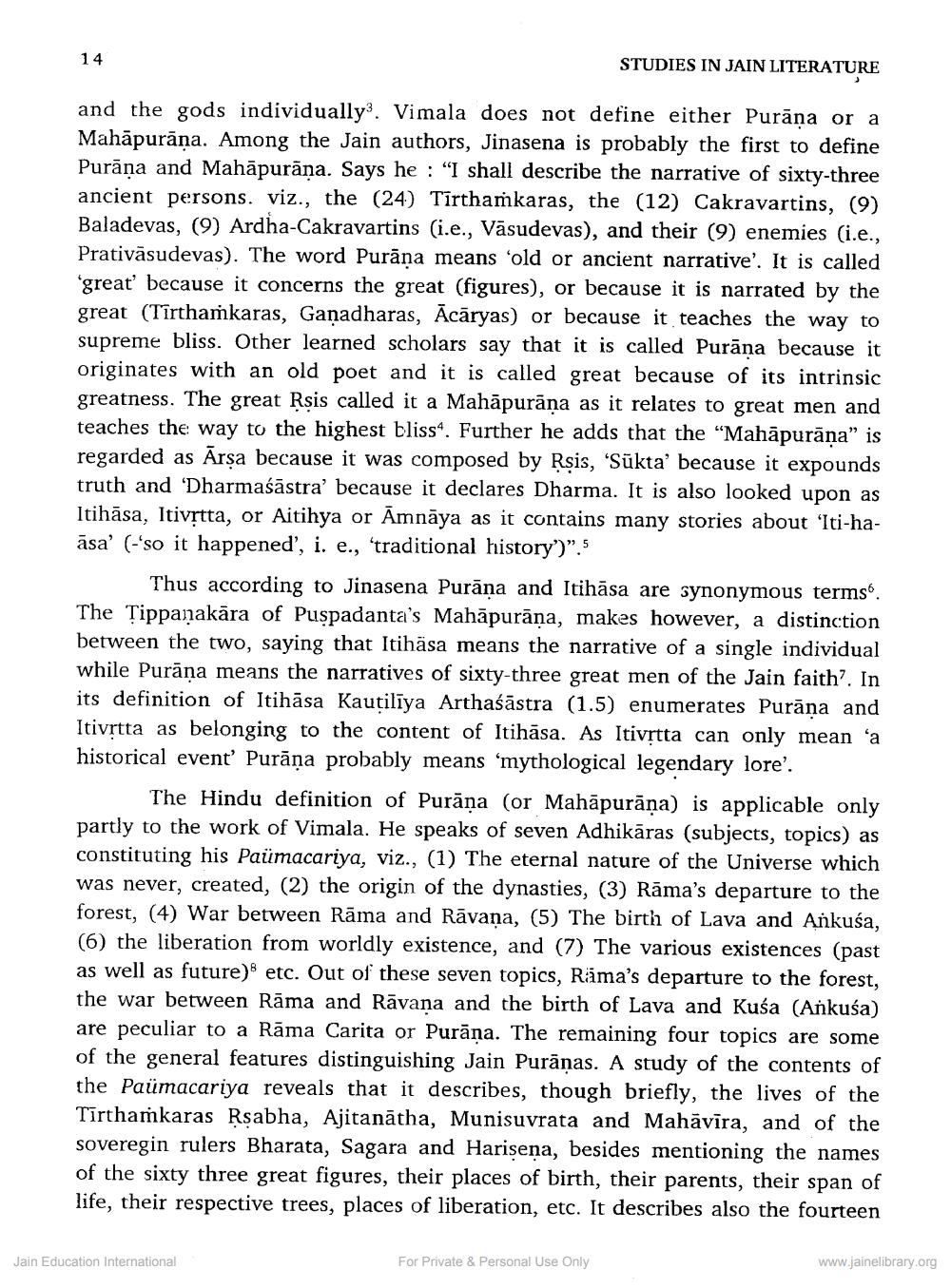________________
14
STUDIES IN JAIN LITERATURE
and the gods individually3. Vimala does not define either Purana or a Mahāpurāṇa. Among the Jain authors, Jinasena is probably the first to define Purāṇa and Mahāpurāṇa. Says he : "I shall describe the narrative of sixty-three ancient persons. viz., the (24) Tīrthamkaras, the (12) Cakravartins, (9) Baladevas, (9) Ardha-Cakravartins (i.e., Vasudevas), and their (9) enemies (i.e., Prativasudevas). The word Purāņa means 'old or ancient narrative'. It is called 'great' because it concerns the great (figures), or because it is narrated by the great (Tirthamkaras, Gaṇadharas, Acāryas) or because it teaches the way to supreme bliss. Other learned scholars say that it is called Purana because it originates with an old poet and it is called great because of its intrinsic greatness. The great Rsis called it a Mahāpurāņa as it relates to great men and teaches the way to the highest bliss4. Further he adds that the "Mahāpurāṇa" is regarded as Ārṣa because it was composed by Rṣis, 'Sukta' because it expounds truth and 'Dharmaśāstra' because it declares Dharma. It is also looked upon as Itihasa, Itivṛtta, or Aitihya or Amnaya as it contains many stories about 'Iti-haasa' (-'so it happened', i. e., 'traditional history')".5
J
Thus according to Jinasena Purāņa and Itihāsa are synonymous terms. The Tippanakāra of Puspadanta's Mahāpurāṇa, makes however, a distinction between the two, saying that Itihäsa means the narrative of a single individual while Purāṇa means the narratives of sixty-three great men of the Jain faith'. In its definition of Itihasa Kautilīya Arthaśāstra (1.5) enumerates Purāņa and Itivṛtta as belonging to the content of Itihasa. As Itivṛtta can only mean 'a historical event' Purāṇa probably means 'mythological legendary lore'.
Jain Education International
The Hindu definition of Purāṇa (or Mahāpurāṇa) is applicable only partly to the work of Vimala. He speaks of seven Adhikāras (subjects, topics) as constituting his Paümacariya, viz., (1) The eternal nature of the Universe which was never, created, (2) the origin of the dynasties, (3) Rāma's departure to the forest, (4) War between Rāma and Rāvaṇa, (5) The birth of Lava and Ankuśa, (6) the liberation from worldly existence, and (7) The various existences (past as well as future) etc. Out of these seven topics, Räma's departure to the forest, the war between Rāma and Ravana and the birth of Lava and Kuśa (Ankuśa) are peculiar to a Rāma Carita or Purāṇa. The remaining four topics are some of the general features distinguishing Jain Purāņas. A study of the contents of the Paümacariya reveals that it describes, though briefly, the lives of the Tīrthamkaras Rṣabha, Ajitanatha, Munisuvrata and Mahāvīra, and of the soveregin rulers Bharata, Sagara and Harisena, besides mentioning the names of the sixty three great figures, their places of birth, their parents, their span of life, their respective trees, places of liberation, etc. It describes also the fourteen
For Private & Personal Use Only
www.jainelibrary.org




